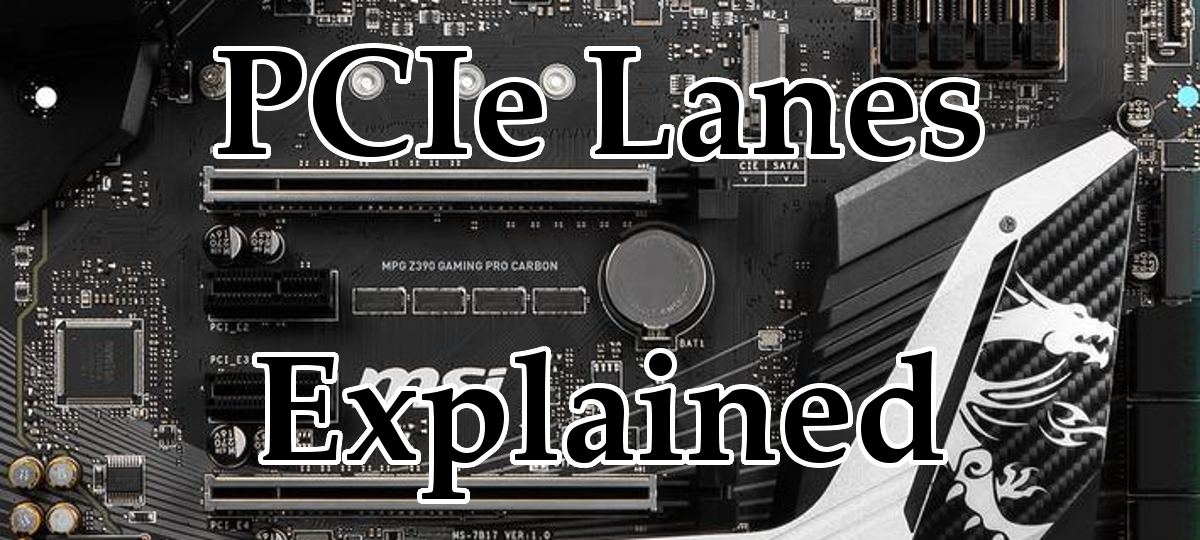
We’ve previously introduced PCIe lanes inData Transfer Rates Compared (RAM vs PCIe vs SATA vs USB vs More!). Today, we review PCIe lanes in more depth, and discuss their relevance to you as a user.
PCIe Lanes: The Gist
On every motherboard, there exist wires used for moving data between installed components. Those wires are calledPeripheralComponentInterconnectexpress (PCIefor short).
PCIe lanes are used for many of the things you plug into your motherboard. This includes everything you put into the array of PCIe slots on your motherboard, like graphics cards or wireless adapters; everything you plug into USB slots; and every storage drive you use, regardless of whether it connected through a SATA header or an M.2 port. The lanes allow them (directly or indirectly) to interact with the core components (CPU and RAM), some of the I/O ports, and with each other.
CPU and Chipset Lanes: Two Sides of the Same Coin?
The CPU and the motherboard chipset are the two brains of the operation. Both “provide” PCIe lanes that you can utilize however you wish. However, these lanes are physically tied to specific parts of the motherboard.
 With Intel CPUs, their PCIe lanes are connected to the PCIe slots on the motherboard. With Ryzen CPUs, the CPU isalsodirectly connected to one M.2 slot (or two SATA 3 ports) and 2 or more USB ports, in addition to some of the PCIe slots.
With Intel CPUs, their PCIe lanes are connected to the PCIe slots on the motherboard. With Ryzen CPUs, the CPU isalsodirectly connected to one M.2 slot (or two SATA 3 ports) and 2 or more USB ports, in addition to some of the PCIe slots.
The chipset’s PCIe lanes are primarily connected to SATA and M.2 slots, most or all USB ports, onboard Ethernet, and may also be connected to some (usually small) PCIe slots.
Everything connected to the CPU can easily move large amounts of data without being severely bottlenecked.But for chipsets, the PCIe lane situation isn’t as rosy—you are limited in speed by the connection to the CPU.This connection is x4 PCIe lanes. In almost all modern systems (2015 and later), this is PCIe 3.0 with 3.94 GB per second maximum. The only notable exception is AMD’s newX570 chipset motherboardsreleased in July; on those, the available bandwidth is doubled with PCIe 4.0 to a pretty comfy 7.88 GB per second maximum. NVMe SSDs, for example, can easily soak up much of this bandwidth on non-X570 motherboards when reading/writing a lot of data, limiting available bandwidth for anything else such as onboard Ethernet, other storage drives, and USB devices that are connected to the chipset. But even just general congestion from using a lot of chipset-mediated data from such sources can potentially cause a problem if there’s enough.
Motherboard Matters
Since the number of PCIe lanes are limited, you can’t plug in to every single slot and port on your motherboard and expect everything to be fine and dandy. Some things may get disabled or have their PCIe lanes limited.
作为PCIe插槽,顶部x16槽通常将work with a full x16 PCIe lanes available at all times. But plug something else into another x16 PCIe slot wired to the CPU, and that number will usually decrease to x8 PCIe lanes. On some motherboards, the second slot in this situation will run with x8 lanes, but may also be limited to x4. (Usually in this case, the x8-second-slot motherboards will support SLI, and x4-second-slot mobos don’t). Plug into yet another PCIe slot, and that top slot may be down to x4 PCIe lanes consistenly available to it.
If you use an NVMe M.2 SSD on a non-X570 chipset motherboard on a slot connected to the chipset, that will usually cut access two SATA 3 ports, since those SATA ports are using PCIe lanes for moving data across the motherboard. This is why you’ll occasionally see warnings on some product pages and sites telling you that populating all available ports of one type will disable some other ports.
 This is really something that depends heavily on the motherboard and the features it offers.Each motherboard’s manual should tell you how many PCIe lanes each PCIe slot uses when multiple are being used, as well as what SATA ports, if any, are disabled when using an M.2 SSD.
This is really something that depends heavily on the motherboard and the features it offers.Each motherboard’s manual should tell you how many PCIe lanes each PCIe slot uses when multiple are being used, as well as what SATA ports, if any, are disabled when using an M.2 SSD.
Conclusion
As far as ourmain chartis concerned:
Every tier up to and including Superb doesn’t suggest X570, meaning everything connected to the chipset rather than the CPU is (as a whole) limited to nearly 4GB/s, and using an M.2 slot may reduce access to some SATA 3 ports. Your freedom is a bit better with the X570 boards suggested in the Excellent, Outstanding, and Enthusiast tiers, so power users who aren’t using Threadripper may enjoy that. However, there is of course nothing (besides money, anyway) to stop you from grabbing an X570 motherboard for any AM4 CPU if you so wish, even if our main chart doesn’t list them lower down for cost/balance reasons.
The typical user in general likely won’t face any serious restrictions because of PCIe lane limitations, and need only worry about what will and won’t work according to the motherboard manual. The speed limitation of the connection between the CPU and chipset may still be a transient concern for some.
If you’ve any questions or anything to add, let us know in the comments! And remember,if you aren’t sure, check the manual.